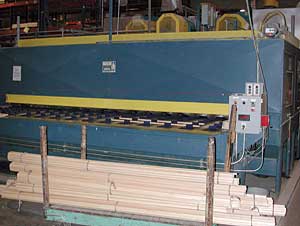Advancements in the manufacture of wood windows and doors
Finishing is a very exacting process. The ultimate goal is to cover every exposed surface with a smooth, even finish. Factory-applied finishes are generally more consistent and smoother than those applied in the field, as the wood window and door components flow through the factory process individually and are free to accept the finishes.
The finishing process includes repetitive sanding, staining of the wood, and the application of two coats of clear protective polyurethane. Before and between the coatings and, after the coating dries, all handling marks, raised grain, scuffs, burnishes, and other undesirable blemishes are removed as it lies in a horizontal position.
 |
| When finished by a manufacturer, wood components are typically first treated with a preservative to fight against the decay caused by fungi or insects. This automated system submerges and dries lineal wood parts in an expedited fashion. |
When components such as finger-jointed wood are painted rather than stained, the first coating is primer. The top coat is then applied by air gun in a closed and controlled room. After finishing, the painted and stained components are passed into a large heated chamber, accelerating the drying process.
Factory finishing is described in both WDMA I.S.-1A-97 (Industry Specification for Architectural Wood Flush Doors) and WDMA I.S.-6A (Industry Standard of Architectural Stile and Rail Doors). According to those standards, "Factory finishing is generally specified when a project requires high-quality performance and superior appearance." Factory finishing offers many benefits:
- State-of-the-art equipment in a dust-free environment provides uniform color, texture, and sheen conditions normally unavailable in the field.
- Frequently in field finishing, numerous limitations prevent proper sanding. If improperly sanded, a window and door lacks the clarity of finish and uniformity of color achievable in factory finishing.
- Factory finishing provides adequate drying time in a dust-free environment.
- It ensures the wood is protected from unfavorable moisture conditions at the earliest possible time.
- In most cases, the cost of factory finishing is lower than the cost of using a separate finishing contractor.
- Factory-finished doors need only to be installed after delivery, which means faster project completion.
The consistency that factory prefinishing offers makes large projects much easier for all involved - the designer, builder, and, ultimately, the owner. The builder will discover increased efficiency, as the windows and doors need only be installed, not painted or stained on site.
Finish selection
Since window and door manufacturers typically offer several standard finishes, the WDMA recommends consulting factory finishing information before specifying the type and extent of prefinishing desired. Many manufacturers also offer non-standard stains, colors, or sheens to match an architect's selection and may provide more than one finish system. Should special window and door finishes be desired, they must be fully described in the specifications. Also keep in mind that specifying non-standard finishes may increase the cost over standard finishes.
The WDMA cautions: "Since appearance and other finish characteristics are somewhat subjective, just the selection of a finishing system does not ensure that the final finish will be acceptable. Selection of a finish should be based on physical samples provided by the door manufacturer to establish the color, grain texture, and sheen."
When selecting a finish, the WDMA reminds the architect to consider the desired appearance, exposure, and maintenance it will require. The associ-ation lists several finishes along with some of their characteristics:
- Oiled finishes provide a natural look, which accentuates the beauty of the wood grain. However, oiled surfaces tend to dry out, leaving the wood with a thirsty, aged look that requires reapplication of oil from time to time.
- Catalyzed lacquer systems contain an ingredient for faster drying and harder film. They have the strength and higher solids of conversion coatings.
- Acrylic lacquer systems are high-quality finishes available in a variety of sheens. The clear finishes are water white in color with excellent non-yellowing qualities.
- Conversion varnish is a high-solids catalyzed alkyd-based coating, offering high resistance to chemicals, moisture, and scratches.
- Catalyzed vinyls have a vinyl-resin base and generally are the most chemically resistant of the conversion coatings.
- Catalyzed polyurethanes have a higher solids content than lacquers and provide high build and excellent hardness.
- Polyesters are very high solids plastic coatings that require special care in handling and application.









